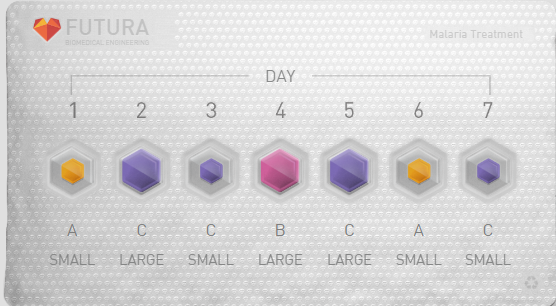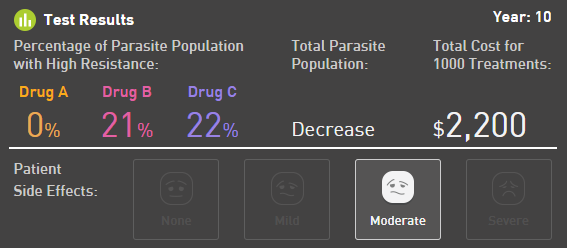


Every year, over half a million people die of malaria. Our goal is to reduce the number of deaths, and reduce the root cause of malaria: a parasite. Since the malaria is caused by parasites, and because those parasites are organisms, they can be killed. Traditionally, a drug is used in order to kill the parasites, but recently, a lot of drugs no longer work on the parasites. It seems that the parasites have developed a resistance of the drug, but how does that happen? First, there is a mutation in the population that changes the genetics in one of the parasites. That gene codes for a protein that gives the parasite a trait that makes it immune to a certain drug. Once that parasite reproduces, it will pass down that gene that codes for the protein that makes the parasite immune to the drug, therefore increasing the number of parasites with that drug immunity. Once the drug is given to the patient, it starts to apply a selection pressure to the parasites. It kills off the parasites that do not have that drug resistance trait, and the parasites with the drug resistance would live. The parasites with the drug resistance trait would reproduce more increasing the total population of the parasites with the drug resistance. As their population increases, more and more parasites would be immune to the drug, making the drug no longer effective. Our mission is to develop not one, but a series of drugs that would end successfully decreasing the population of the parasites, while reducing the amount of resistance to the drugs and human side effects along the way. We want the world to be a better place by combating malaria.
A piece of data we have to prove this is that the percentage of drug resistance to Drug A is 0%, Drug B is 21%, and Drug C is 22%. This data shows that our antibiotics have a low change of being resisted by the parasites, therefore killing them off reliably. Although the average resistance is still above 10%, we decided to settle with this antibiotic because of some tradeoffs. We lowered the cost by using less expensive antibiotics, which weren’t as effective at lowering resistance, but kept cost at a reasonable amount in order to be able to produce more antibiotics and help more people. So, in summary we ended up with a higher drug resistance, but sympathized with a lower cost. Another piece of data we have to prove our claim is that the overall population of parasites showed a decrease. This means that our antibiotics worked efficiently at killing off parasites, which caused a decrease in their population. A tradeoff for this was that the patient side effects were moderate. This is due to the fact that the antibiotics that were more potent towards the parasites, and therefore worse side effects. In the end, we decided to make our antibiotics more efficient at killing of the parasites to cause a decrease in their population, but ended up with moderate patient side effects. Drug description and data is shown down below.


Copyright © 2024 The Green Cross All Rights Reserved
Copyright © 2024 The Green Cross All Rights Reserved
Copyright © 2024 The Green Cross All Rights Reserved